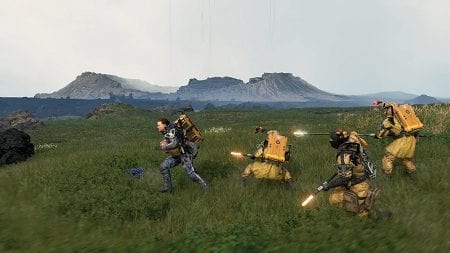Video Game Review: Death Stranding

Delivery service is much more dangerous in the future.
Wrapped up in secrecy for so many years, Hideo Kojima‘s first post-Metal Gear project is finally here and people are stuck on the bizarre (naked Norman Reedus, babies in capsules) as well as the traditional (a lot of walking, stealth combat). The truth is that Death Stranding is all of that and then some. Built from many different elements, Death Stranding winds up being more than the sum of its parts as it creates a bizarre (but actually not that bizarre), intense and beautiful experience.
CONTROLS (3.75/5)
One thing you knew you were getting with any Metal Gear Solid title was that, for their time, they had controls that were fine-tuned, and in some ways, cutting edge. Kojima has always been a stickler for detail, and having crisp controls is part of it.
That being said, Death Stranding is a different experience than Metal Gear Solid and the controls reflect that. MGS was about precision with shooting and stealth, while Death Stranding is much more concerned with movement. To that end the R2 and L2 buttons are used in unique ways to represent balance in various situations, from walking down a slope to handling the rush of water.
This mechanic differentiates it from the otherwise standard third-person controls, and because they don’t snap to a targeting reticule or trigger pool, it’s hard to really assign how sharp they are other than they seem effective. There are traditional weapons and melee combat, and these are all effective, though not groundbreaking in any way.
However, one of the issues with Death Stranding‘s controls is that much of its interactions are menu driven. And the menus themselves are dense with information — key information and supplementary information, along with really small font and various statistics.
This means it takes a while to understand the navigation and meaning in the menus, and as anyone in software can tell you, when you have confusing menu systems, that’s a bad user experience. Ultimately they get the job done, but the density of information in menus often creates as many problems as it solves.
GRAPHICS/SOUND (5/5)
Death Stranding may be the best-looking game of this console generation. From the uncanny valley of its characters to the tiniest details of the environment, such as when someone steps in damp earth, the game’s graphics are a feast in all manners.
Detailed and realistic, Death Stranding also smartly uses lighting and environments to heighten tension and horror elements when called upon. It’s not stylized in a way that, say, Borderlands or Control are, but for pure technological power it’s clearly the cream of the crop.
Hollywood actors don’t always give good performances in video games, but Death Stranding will go down as a good example of blurring the line between the game and film industries. Lead actors Reedus, Lea Seydoux and Mads Mikkelson all deliver performances on par with their live-action work, and all of the supporting voice actors do a fine job, especially Kojima veteran Troy Baker as Higgs.
Of course, sounds is more than just dialogue, and Kojima’s experience using sound and music to enhance the moment has been notable throughout the Metal Gear series. Death Stranding is no different; from the terrifying shifts that lead to BT encounters to the way the game plays mellow electronic music while navigating wide expanses, the sound design is perfect.
GAMEPLAY (4.5/5)
There’s been a lot of early buzz about how Death Stranding is unlike any game that you’ve played, and that in some ways it’s a glorified walking simulator. That is both true and false; the game treats terrain as an antagonist, but after the opening 10 hours — when different gameplay and story elements gradually build upon each other — it becomes very similar to Metal Gear Solid V: The Phantom Pain. It’s an open world with story and side missions assigned, and as each of those get completed, new tools and weapons become available.
When traversing terrain, you’re given a choice as to how you get from A to B — go around, use your tools to go over, or some combination of. There’s freedom in this creativity as you battle the elements, and much of the focus on early buzz has been on this “terrain as an antagonist.” However, there’s far more involved to the game.
Vehicles open up speed and options, combat with mercs known as MULEs bring traditional Metal Gear Solid elements, and horror elements get into the mix with the mysterious ghost-like BTs. Like The Phantom Pain, missions focus on different elements, and the middle segment of the game lasts about 10-to-20 hours depending on how you play.
This is augmented by the game’s innovative community aspect. As you recover the world of Death Stranding, everyone chips in. That means anything from ropes to ladders to storage lockers to massive roads appear over the course of your gameplay, along with signs of encouragement and warning.
You can recover dropped cargo left by other players, or contribute your found materials into the building/upgrading of larger structures, and you’re encouraged to give/earn “Likes” within the community as you encounter this. It gives a significant feeling of community despite the vast stretches of empty territory.
The final 10 hours of the game are intense and filled with boss encounters, set pieces, and an intensifying story. This entire combination creates a package (with side quests, up to 50-to-70 hours of gameplay) that is unlike any other — a bonkers story, high production values, unique gameplay mixed with traditional gameplay, and an online community.
OVERALL (4.5/5)
Death Stranding is certainly not for everyone, but Kojima has thrown elements of No Man’s Sky, Sim City, Journey, Metal Gear Solid, The Last of Us and survival horror into a unique mix that gradually builds into an unforgettable experience, all while creating a special narrative musing on the nature of human connection.







